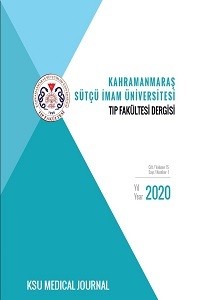Abstract
Amaç: Port kateterleri çocuk hematoloi-onkoloji hastalarında ilaç uygulamaları için kolay bir vasküler erişim yöntemi sağlamaktadır. Bu retrospektif çalışma ile çocuk hastalarda uyguladığımız venöz port kateter uygulamalarının literatür eşliğinde irdelenmesi amaçlanmıştır.
Gereç ve Yöntemler: Port kateter uygulaması için ilk tercih sağ internal juguler ven idi. Bu bölge kullanılamadığında kontrlateral internal juguler ven tercih edildi. İşlem ultrasonografi eşliğinde genel anestezi altında ameliyat odasında gerçekleştirildi. Tüm hastalar işlemden sonra pnömotoraks, kateter oryantasyonu, bükülmesi ve malpozisyon i göğüs grafisi ile açısından değerlendirildi.
Bulgular: 11.02.2016 - 13.12.2019 tarihleri arasında toplam 26 pediatrik hastaya vasküler port kateteri yerleştirdik. Port kateter uygulaması için endikasyon uzun süreli kemoterapi uygulaması idi. Ortalama yaşı 6.96 (1 ile 16 arasında değişmektedir) olup 20 (% 76.9) erkek ve 6 (% 23.1) kız çocukdan oluşmaktaydı. Port kateter yeri olarak 23 çocukda sağ internal jugular ven, 3 çocukda sol internal jugular ven tercih edildi. 2 (%7.7) hastada port enfeksiyonu, 3 (%11.5) hastada port trombozu nedeniyle port çıkarıldı. Hiçbir hastada hemotoraks, pnömotoraks, ven trombozu gelişmedi.
Sonuç: Port kateterini USG eşliğinde daha düşük komplikasyon oranları ile uygulamak mümkün olmaktadır. Ayrıca bu uygulama ile çocuk hastaların ve ailelerinin tedaviye uyumu ve günlük yaşam kalitesinin artacağı kanaatindeyiz.
Keywords
References
- Kaynaklar 1-Mirro J Jr, Rao BN, Stokes DC, Austin BA, Kumar M, Dahl GV, et al. A prospective study of Hickman/Broviac catheters and implantable ports in pediatric oncology patients. J Clin Oncol 1989;7:214-22. 2-Zhang Q, Jiao L, Zhou H. Comparison of implantable central venous ports with catheter insertion via external jugular cut down and subclavian puncture in children: single center experience.Pediatr Surg Int 2009; 25(6):499-501. 3-Rosen M, Latto IP, Shang W. Handbook of percutaneous central venous catheterization. Philadelphia. W.B. Saunders Company Ltd; 1981. 4-Tremolada M, Axia V, Pillon M, Scrimin S, Capello F, Zanesco L. Parental narratives of quality of life in children with leukemia as associated with the placement of a central venous catheter. J Pain Symptom Manag 2005;30:544-552. 5-Krupski G, Froschle GW, Weh FJ, Schlosser GA. Central venous access devices in treatment of patients with malignant tumors: Venous port, central venous catheter and Hickman catheter. Cost-benefit analysis based on a critical review of the literature, personal experiences with 135 port implantations and patient attitude. Chirurgie 1995;66:202-7. 6-Groeger JS, Lucas AB, Thaler HT, Friedlander-Klar H, Brown AE, Kiehn TE, et al. Infectious morbidity as¬sociated with long-term use of venous access devices in pa¬tients with cancer. Ann Intern Med 1993;119:1168-74. 7-de Jonge RC, Polderman KH, Gemke RJ. Central venous catheter use in the pediatric patient: mechanical and infectious complications. Pediatr Crit Care Med 2005;6:329-39. 8-Kock HJ, Pietsch M, Krause U, Wilke H, Eigler FW. Implantable vascular access systems: experience in 1500 patients with totally implanted central venous port systems. World J Surg 1998;22:12-6. 9-Doyurgan O, Karagöz U, Karaçelik M, Vergin RC, Sarıosmanoğlu ON. Çocuklarda Subkutan Port Kateter İmplantasyonuna Bağlı Komplikasyonlar ve Tedavi Stratejileri. Damar Cer Derg 2016;25(2):66-72. 10-Cil BE. Radiological placement of chest ports in pediatric oncology patients. Eur Radiol 2004;14:2015-2019., 11-Koroglu M, Demir M, Koroglu BK, Sezer MT, Akhan O, Yildiz H, et al. Percutaneous placement of central venous catheters: comparing the anatomical landmark method with the radiologically guided technique for central venous catheterization through the internal jugular vein in emergent hemodialysis patients. Acta Radiol 2006;47:43-47. 12-Lorch H, Zwaan M, Kagel C, Weiss HD. Central venous access ports placed by interventional radiologists: experience with 125 consecutive patients. Cardiovasc Intervent Radiol 2001; 24:180-4. 13-Cimochowski GE, Worley E, Rutherford WE, Sartain J, Blondin J, Harter H. Superiority of internal jugular over sub¬clavian access for temporary dialysis. Nephron 1990;54:154-61. 14-Teichgräber UK, Pfitzmann R, Hofmann HA. Central venous port systems as an integral part of chemotherapy. Dtsch Arztebl Int 2011; 108:147-53. 15-Wiegering V, Schmid S, Andres O, Wirth C,Wiegering A, Meyer T, et al. Thrombosis as a complication of central venous access in pediatric patients with malignancies: a 5-year singlecenter experience. BMC Hematol 2014;14:8. 16-Gann M Jr, Sardi A. Improved results using ultrasound guidance for central venous access. Am Surg 2003;69:1104-7. 17-Randolph AG, Cook DJ, Gonzales CA, Pribble CG. Ultrasound guidance for placement of central venous catheters: a metaanalysis of the literature. Crit Care Med 1996;24:2053-8. 18-Gebauer B, El-Sheik M, Vogt M, Wagner HJ. Combined ultrasound and fluoroscopy guided port catheter implanta¬tion-high success and low complication rate. Eur J Radiol 2009;69:517-22.
Details
| Primary Language | Turkish |
|---|---|
| Subjects | Health Care Administration |
| Journal Section | Araştırma Makaleleri |
| Authors | |
| Publication Date | March 26, 2020 |
| Submission Date | January 10, 2020 |
| Acceptance Date | February 3, 2020 |
| Published in Issue | Year 2020 Volume: 15 Issue: 1 |

